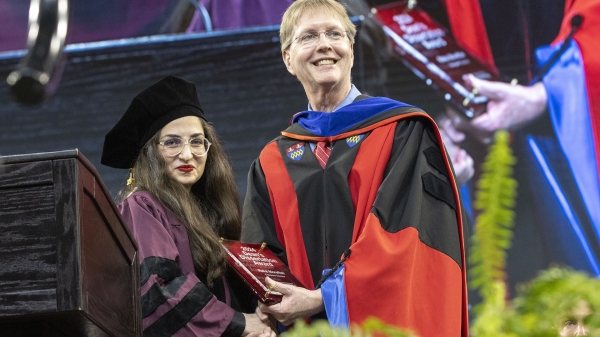The importance of parents when starting college during a pandemic

Jinni Su, ASU assistant professor of psychology.
A new study has shown that parent-child relationships protected students who started college in the midst of the pandemic from alcohol misuse and mental health problems.
The study followed 425 first-year students who started college in the fall 2020 semester, a time when many classes were still offered remotely and social distancing impacted extracurricular activities. Nearly half of the participants reported mental health struggles, alcohol use or a combination of both. The work was published online March 3 in Child Psychiatry and Human Development.
“This study shows that parents are an important source of support to college students and that they continue to play an important role in their child’s life,” said Jinni Su, assistant professor of psychology at Arizona State University. “A strong relationship between students and parents is protective and goes a long way towards shielding them from mental health and alcohol use challenges that can happen during the transition to college, in particular during this pandemic.”
The study participants were the first group to enroll in the Pathways to College Health study, led by the Genes, Environment and Youth Development Lab. The goal of this long-term study is to identify risk and protective factors in college students. The research team asked participants whether they experienced symptoms of depression and anxiety, how often and how much they drank alcohol, and about their relationship with their parents.
Because the study launched in October 2020, Su and her team assessed what impact the pandemic had on the students’ transition to college. The participants answered questions about whether the COVID-19 pandemic had resulted in major life events such as a loved one being ill or hospitalized, or whether it was associated with job loss. The researchers also asked how much the participants worried about how the disease affects themselves and their loved ones.
The participants were classified into four groups based on their patterns of alcohol use behaviors and mental health during their college transition: well-adjusted; experiencing mental health problems; using alcohol; and those who reported both using alcohol and experiencing mental health problems.
Students who reported that COVID-19 had caused stressful life events like job loss or the hospitalization of a loved one were more likely to be in the alcohol use group or among those who reported both alcohol use and mental health problems.
Worrying about the pandemic increased the risk of experiencing mental health problems but not alcohol use.
“We found substantial variation in student adjustment to college during a pandemic, and the good news is a bit more than half of students adapted quite well,” Su said. “Before the pandemic, mental health challenges were an issue for college students, with about one in five reporting depressive and anxiety symptoms. The findings from this study show that mental health is an even more important issue today, especially for students who have experienced more COVID-19-related stressors.”
Having a high quality relationship with their parents meant students were less likely to be negatively impacted by the pandemic. These students were less likely to experience mental health problems and to report both alcohol use and mental health problems.
“Our findings also show that students can continue to lean on their parents, particularly during these difficult times,” Su said.
Toward resilience by understanding risk and protection
One of the main goals of Su’s research is to understand what effect factors like genes, friends or the family environment have on whether someone is well adjusted, experiences mental health challenges or misuses alcohol.
“It is important to understand the factors that promote resilience, to know which factors make some students continue to struggle,” Su said. “In the future, we plan to look at how genes interact with experiences, including stressors related to COVID-19, and how someone’s genetic risk comes together with their different environmental experiences to shape mental health and alcohol use patterns over time.”
The study was funded by a grant from the Institute for Mental Health Research and funds from ASU. Two of Su’s students contributed to the study: recent ASU alumna Isobel Conroy and current graduate student Angel Trevino.
More Science and technology
Extreme HGTV: Students to learn how to design habitats for living, working in space
Architecture students at Arizona State University already learn how to design spaces for many kinds of environments, and now they…

Human brains teach AI new skills
Artificial intelligence, or AI, is rapidly advancing, but it hasn’t yet outpaced human intelligence. Our brains’ capacity for…

Doctoral students cruise into roles as computer engineering innovators
Raha Moraffah is grateful for her experiences as a doctoral student in the School of Computing and Augmented Intelligence, part…